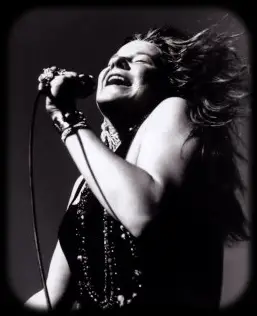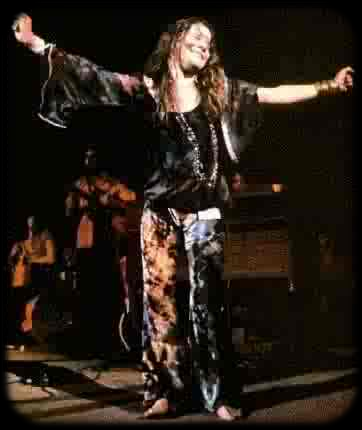JANIS JOPLIN

With a voice capable of conveying excruciating pain and heartbreaking tenderness, Janis put herself out there in every performance, lost in the music and with raw emotion bleeding from every note.
Some Blues Divas go on for ever, and some just aren’t meant to make old bones. Janis Joplin was one of the latter, joining the ’27-Club’ just two weeks after Jimi Hendrix had checked in.
Bessie Smith, another hard-living, wild-loving bisexual woman and perhaps Janis’s biggest influence, also died relatively young.
Janis was born in 1943, in Port Arthur, Texas. She was not popular in high school but Janis found an outlet in her painting, and began to hang out with a bunch of outsiders, including future ‘Furry Freak Brothers’ cartoonist Gilbert Shelton, who were into folk and blues music, listening to Bessie Smith, Ma Rainey and Lead Belly.
While Janis was at University in Austin, she made her first home recordings, playing autoharp on her song ‘So Sad to Be Alone’. Determined to make it as a singer, she moved to San Francisco in 1963, where an ‘alternative society’ was taking shape. This atmosphere of freedom involved drug use, including heroin and amphetamines, promiscuous sex and heavy drinking.
Janis loved the music scene, and she recorded some Blues classics and original songs with future Jefferson Airplane guitarist Jorma Kaukonen. These home recordings were later bootlegged as ‘The Typewriter Tapes’ because Jorma’s wife used her typewriter as a percussion instrument on some tracks. Worried by her depression (a life-long problem) and severe drug use, Janis’s friends persuaded her to return to Texas.
This beautiful visual tribute is over a pre-Big Brother recording of a song about how drugs will kill you:
Recommended Album
You don’t need a fantastic voice to be a great singer. Janis’ voice has it’s faults, but she can knock you down with her emotional power.
Pearl

Janis enrolled at Lamar University, gave up drugs and began performing on the Austin music scene. Here she met up with Chet Helms, who persuaded her to drop out and move back to San Francisco where he was involved with a band called Big Brother and the Holding Company. They performed on the vibrant Bay Area scene, and Janis’s captivating stage presence put her in the spotlight, but she also reverted to using drink and drugs. Big Brother recorded the ‘Cheap Thrills’ album in 1967, including a stunning version of Big Mama Thornton‘s ‘Ball and Chain’, and it was the top selling album in the US for eight weeks. It’s release co-incided with their appearance at the Monterey Pop Festival, and the subsequent film, showing Janis’s full-blooded outpouring of emotion, gave Big Brother a global profile. After touring for a year, Janis announced that she was going solo.
In early 1969, Janis’s management recruited The Kosmic Blues Band from young musicians, several of whom went on to form Steppenwolf, and included a horn section. They recorded a soul-blues album, ‘I Got Dem Ol’ Kosmic Blues Again, Mama’ which went gold, and the band toured extensively, as documented in the film ‘Janis’. Her appearance at Woodstock later that year was tarnished by her obvious drugged state, and Janis insisted that her footage was not used in the cinema release of the movie. By the end of the year the band broke up, giving a final concert at Madison Square Gardens with guests Johnny Winter and Paul Butterfield.
Janis just did not know how to hold back:
Janis was discovered in a motel room in LA, on October 4th 1970, dead from a heroin overdose. She was 27 years old. Janis spent the early months of 1970 in Brazil, where she was drug-free, but when she returned to California and her female lover, who was an intravenous drug user, she began using heroin again. Her next project, The Full-Tilt Boogie Band, started life with a short tour of Canada, and they spent the summer gigging. Janis appeared with feathers in her hair, looking every inch the ‘rock-chick’, and pouring her soul into every song.
Janis and the band went into the studio to record the album ‘Pearl’ (her nick-name) but it was released posthumously, selling 4 million copies in the US alone. The track ‘Buried Alive in the Blues’ was included without the vocals she was due to put down on the day her body was found.
The 27 Club
1970 was a big year for rock deaths. Al Wilson of Canned Heat died in a drug related incident in LA, followed by by Jimi Hendrix in London. Janis Joplin went the same way in LA two weeks later. They were all 27 years old. Jim Morrison perished in Paris the following year; Kurt Kobain joined in 1994 and Amy Winehouse is the latest recruit, but vodka was her poison. Of course, the founder member of the club was Robert Johnson, who was given a fatal bottle of strychnine spiked whiskey in 1938.
How old was Janis Joplin when she died?
Janis was just 27 years old when she died on October 4, 1970, leaving behind a legacy that would influence generations of musicians to come. Her music was raw, honest, and emotive, capturing the spirit of the counterculture movement of the 1960s. Janis Joplin performing was described as "scorching," "soulful," and "raspy," was the embodiment of the blues.
Who were Big Brother And The Holding Company?
Big Brother and the Holding Company was a San Francisco based band in the mid-1960s. They were one of the first bands to emerge out of the counterculture movement in the Bay Area, alongside artists like the Grateful Dead and Jefferson Airplane. The band was known for their psychedelic sound and their association with lead vocalist Janis Joplin.
When Joplin joined the band in 1966, they quickly gained a following on the San Francisco music scene, playing at venues like the Avalon Ballroom and the Fillmore Auditorium. It was at one of these performances that they were discovered by producer and music entrepreneur Chet Helms, who convinced the band to move to San Francisco and become part of the city's burgeoning music scene.
Big Brother and the Holding Company gained national attention with the release of their second album, Cheap Thrills, in 1968. The album, which featured songs like "Piece of My Heart" and "Ball and Chain," was a massive commercial success, spending eight weeks at the top of the charts and cementing Joplin's status as a rock and roll icon.
Despite their success, Big Brother and the Holding Company struggled with internal tensions and personnel changes, and Joplin ultimately left the band to pursue a solo career in 1968. The band continued to perform and record without her, but never achieved the same level of success.
Who were the Full Tilt Boogie Band?
The Full Tilt Boogie Band was the backing band that Janis Joplin put together for her solo career after leaving Big Brother and the Holding Company in 1968. The band consisted of seasoned musicians, including guitarist John Till, drummer Clark Pierson, and bassist Brad Campbell, among others. They were known for their tight, energetic performances, which complemented Joplin's powerful vocals perfectly.
Joplin and the Full Tilt Boogie Band toured extensively throughout the US and Europe, including an appearance at the historic Woodstock festival in 1969. They also recorded an album together, Pearl, which was released posthumously after Joplin's death in 1970. The album was a commercial and critical success, featuring hits like "Me and Bobby McGee" and "Cry Baby."
The Full Tilt Boogie Band continued to perform after Janis Joplin's death, but without their dynamic frontwoman, their momentum eventually waned. Nonetheless, they remain an important part of Joplin's legacy, representing a key chapter in her career and the evolution of rock and roll.